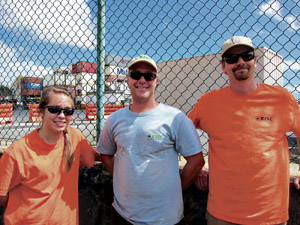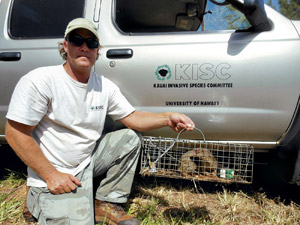Fighting Off A Mongoose Invasion
Before this year, sighting a mongoose on Kaua’i was akin to finding Big Foot on the Mainland.“But we never even had a fuzzy picture,” says Pat Gmelin, pest survey and response aide for Kaua’i Invasive Species Committee.
Unfortunately, times have changed in recent months, and sightings of the highly invasive species that poses a serious threat to the island’s rare native birds are becoming less elusive.
In fact, two have been trapped recently by Gmelin and his team in Lihu’e.
“Most of the public didn’t believe it,” says Gmelin. “Until it was actually in the trap in the cage, no one believed it, even people who worked in conservation. May 23 marked the first time in documented history that a mongoose has been caught on the island.”
Before that, in 1976, a mongoose was discovered as road kill. The mongoose at that time had been a lactating female, implying there were others.
Until now, there had been many credible sightings throughout the decades, but never any physical evidence.
The means by which they are getting to the island is likely via the thousands of containers that arrive regularly on Kaua’i without undergoing routine inspections.
“So all this stuff comes here and anything can come in,” says Gmelin.
The main point of entry is thought to be Nawiliwili Harbor, where the most sightings occur.Leading up to the May capture, 15 credible sightings from the harbor to the Marriott’s Kaua’i Lagoons were reported within a month before a mongoose was finally trapped next to the golf course. It is still unknown whether all the sightings were of this particular mongoose or more, as the mammals can travel several miles a day.
A second mongoose was apprehended June 29 next to the Young Brothers’ loading dock in Nawiliwili. Gmelin believes the harbor is their main point of entry, which includes not only containers, but cruise ships traveling from other islands, military ships and people’s private boats.
While most are believed to arrive by accident as stowaways, there is a theory that some people who have issues with the island’s wild chickens may be bringing them in on purpose with the intent of decreasing the jungle fowl’s population.
“But chickens aren’t really a big priority issue in the whole scale of things,” says Gmelin.
Originally, mongooses were intentionally brought to the Islands by sugar cane companies in the late 1800s, as it was believed they would help control the rat population.
“But they didn’t research it and it was a bad, bad mistake because they found out too late that mongooses don’t control rats because rats are nocturnal and mongooses are diurnal,” explains Gmelin. “They don’t really see each other.”
Luckily, mongooses were either never brought to Kaua’i or they weren’t able to establish themselves on the Garden Isle.
Interestingly enough, while they endanger the Islands’ fragile ecosystems, the mongoose is actually a rather amazing creature.They are famous for fighting cobras, as the children’s tale Rikki-Tikki-Tavi depicts, because they are faster than the venomous snakes and are immune to their poisonous bite.
Nonetheless, if this creature established itself on the island, native birds, whose eggs and chicks the mongoose likes to eat, could face extinction rates similar to the other main Hawaiian islands where the invasive species is well-rooted.
In an effort to help, the nonprofit Kaua’i Invasive Species Committee has set up live traps around the harbor and the Marriott Kaua’i Lagoons that are routinely monitored. Once a mongoose is lured into a trap by strong-smelling food such as tuna, KISC follows a humane protocol where the mongoose is put to sleep.
Perhaps, in the future, the mongooses may even be sent back to India, where Hawaii’s particular species originated.
“But it’s too cost-prohibitive now,” says Gmelin.
KISC has been on the island for approximately 11 years protecting Kaua’i from all invasive species including vegetation, coqui frogs and fire ants. Because of emerging needs, the group recently received funding from the state in order to accomplish more extensive mongoose trapping on Kaua’i.
Though sightings, which undergo a sound credibility test, have been reported around the entire island, KISC is currently investigating some highly legitimate sightings in Kilauea.
“I care about Hawaii’s native plants and animals, and I feel like I can make a difference,” says Gmelin. “I really do care about the island, and any small impact that I can make I think is worth it.”
To report a mongoose sighting, call 821-1490. Visit kauaiisc.org for more information.






